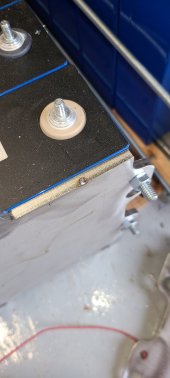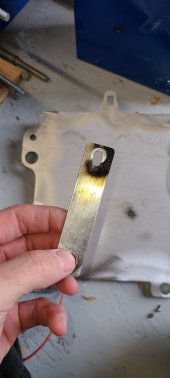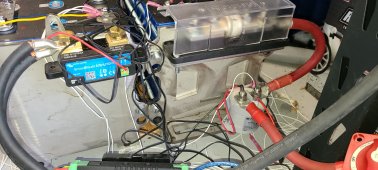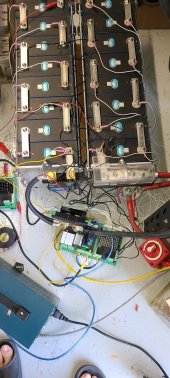Hi all!
This wasn't supposed to be the kind of first thread I make, but thought I would share a... could have been way bad... situation that I had a fortunately mild outcome from but could easily have devastating results.
I was in the process of getting fixture plates laser cut and making adjustments to the template and thought just a quick test wouldn't hurt. I didn't have insulating material between the cells and the fixture plates and I think a spec of weld splatter or a sand granule punctured the side of the cell film on my most positive cell. I then was disassembling the cell pack to take my findings in to make adjustments to the drawings for a new cut and touched the most negative busbar against the fixture. I had planned to make the fixture and frame work all negative ground anyway so it didn't cross my mind of the possibility of a short circuit. I also had already removed the positive fuse. But BANG! The flash shooting up the positive terminal was far brighter than the actual cause of the short on the negative.
The cell melted through the aluminum casement on the sides and around the post. It is leaking electrolyte out of the side and top. (by the way, how should I now dispose of this leaking cell, it is/was around 30-40% SoC?).
What is interesting to me, is that the way the aluminum burned rapidly around the post itself, reminds me a lot of https://diysolarforum.com/threads/last-fire.25937/ 's fire and I wonder if he had cell casing to cell casing short that triggered his.
I had planned to put cnc routered insulators between the plates and cells and then strips of pvc liner between each cell. And pvc tubing on the threads (have it on the bottom rods, but not the sides in my test setup, as I was being "careful" to not touch the cells).
The real bummer is that I had 4 extra cells I meant to use as a way to sort out the weakest capacity cells and then use those 4 in my rv. Now I have an odd series count and will have 'spares' I suppose.
This wasn't supposed to be the kind of first thread I make, but thought I would share a... could have been way bad... situation that I had a fortunately mild outcome from but could easily have devastating results.
I was in the process of getting fixture plates laser cut and making adjustments to the template and thought just a quick test wouldn't hurt. I didn't have insulating material between the cells and the fixture plates and I think a spec of weld splatter or a sand granule punctured the side of the cell film on my most positive cell. I then was disassembling the cell pack to take my findings in to make adjustments to the drawings for a new cut and touched the most negative busbar against the fixture. I had planned to make the fixture and frame work all negative ground anyway so it didn't cross my mind of the possibility of a short circuit. I also had already removed the positive fuse. But BANG! The flash shooting up the positive terminal was far brighter than the actual cause of the short on the negative.
The cell melted through the aluminum casement on the sides and around the post. It is leaking electrolyte out of the side and top. (by the way, how should I now dispose of this leaking cell, it is/was around 30-40% SoC?).
What is interesting to me, is that the way the aluminum burned rapidly around the post itself, reminds me a lot of https://diysolarforum.com/threads/last-fire.25937/ 's fire and I wonder if he had cell casing to cell casing short that triggered his.
I had planned to put cnc routered insulators between the plates and cells and then strips of pvc liner between each cell. And pvc tubing on the threads (have it on the bottom rods, but not the sides in my test setup, as I was being "careful" to not touch the cells).
The real bummer is that I had 4 extra cells I meant to use as a way to sort out the weakest capacity cells and then use those 4 in my rv. Now I have an odd series count and will have 'spares' I suppose.










